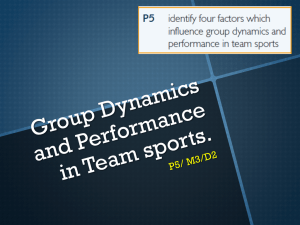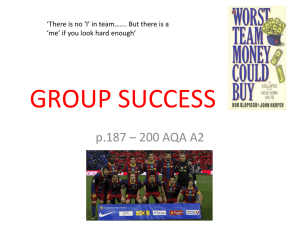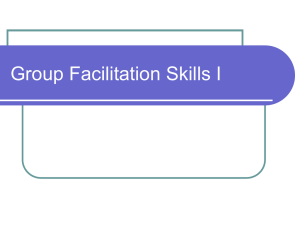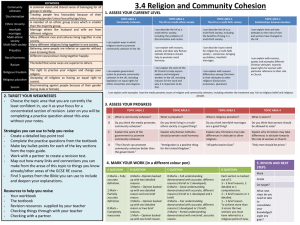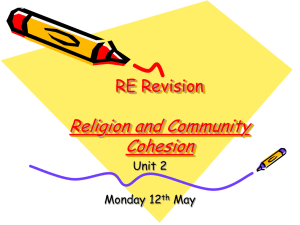Social Dimensions - PE Studies Revision Seminars
advertisement
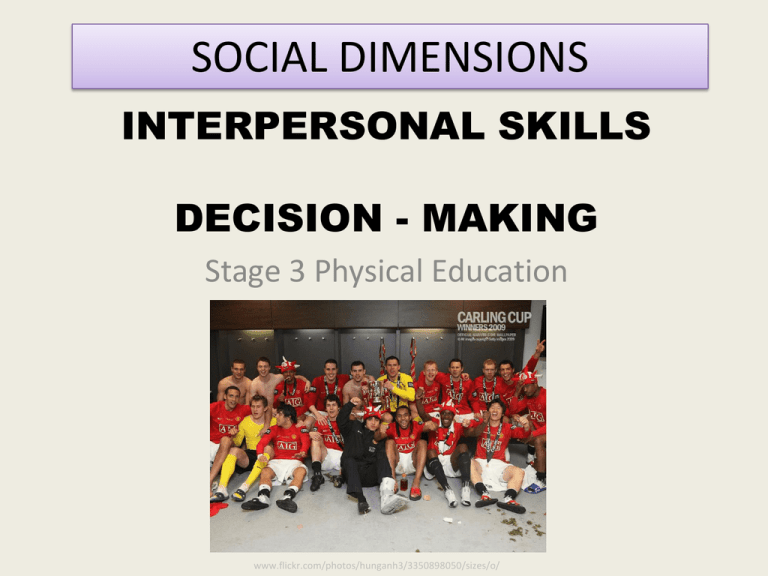
SOCIAL DIMENSIONS INTERPERSONAL SKILLS DECISION - MAKING Stage 3 Physical Education www.flickr.com/photos/hunganh3/3350898050/sizes/o/ Contents 1. Leadership 2. Chelladurai's Multidimensional Model of Leadership 3. Leadership Status for Sport (LSS) 4. Sociograms 5. Group dynamics - teams / groups 6. Group Dynamics - stages of group development 7. Group Dynamics – roles / norms 8. Group cohesion 9. Carron’s Model of Group Cohesion 10. Factors affecting cohesion 11. Measuring cohesiveness 12. Developing cohesion 13. Benefits of cohesion ©PE STUDIES REVISION SEMINARS 2 Contents 13. Barriers to cohesion 14. Social Loafing 15. Change management 15. Resistance to change 16. Managing change 17. Ethics in sport 18. Making ethical decisions 19. Decision making 20. Life coaching and change management 21. Equity and social justice 22. Barriers to, and promoting physical activity in different groups 23. Solution focused decision making 24. Appreciative enquiry 25. Critical thinking 26. References ©PE STUDIES REVISION SEMINARS 3 Chelladurai’s Multidimensional Model of Leadership (MDML). Chelladurai’s Multidimensional Model of Leadership Factors / Antecedents* Leader Behaviour Situational characteristics Required behaviour Leader characteristics Actual behaviour Member characteristics Preferred behaviour ©PE STUDIES REVISION SEMINARS Diagram reproduced with permission from P Chelladurai Consequences Member Satisfaction Group Performance 4 Chelladurai’s Multidimensional Model of Leadership (MDML). Chelladurai’s MDML states that a leader will be more effective if the team’s satisfaction with the leader is high. A team which is not satisfied with its leader will not demonstrate the same level of performance and satisfaction. A leader’s behaviour is influenced by 3 factors (antecedents); 1. Situational Characteristics The environment in which the leader is performing in, including whether the group is large or small, elite or social, a team or individual sport, and the game’s relative importance. 2. Leader (personal) characteristics including past experiences, temperament, personal qualities, skills, expected standards, decision making styles. 3. Group member characteristics The gender, age, skill level, cultural background, motivation and experience of the player group affects the manner in which the coach behaves. ©PE STUDIES REVISION SEMINARS 5 Chelladurai’s Multidimensional Model of Leadership (MDML). 1. Required Behaviour 3. Preferred Behaviour 2. Actual Group satisfaction and performance at its highest Behaviour If a leader is required to behave in a specific manner (1) in a certain environment and does so (2), and if this behaviour is what is preferred by the group (3), then there is a high likelihood that the group will be satisfied with the leader and the way in which they are being led and a higher level of performance result. ©PE STUDIES REVISION SEMINARS 6 Leadership Sociograms Determining Leadership in a Netball Team Green arrow from one player (represented by a circle) to another, indicates support for this person as a leader. Red arrow indicates rejection as a leader What can the coach learn? Well supported as leader. No rejections. Suitable vice captains. Less support but no rejections No support 2 rejections Avoid using as leader! 2 0 2 2 0 6 3 0 0 0 0 The number in circle shows the number 7 of players who support her as a leader Group Dynamics • Group Dynamics refers to the interactive nature of individuals within the contexts of a group. • A group is a collection of at least two individuals who interact over a period of time, develop a collective identity and who have shared interests, norms and values eg weight watchers groups, study groups, social groups. • A group can have common goals but the group does not depend on all members to perform in order to achieve these goals eg aerobics classes can achieve different results within the group. An aerobics class is a group because the members have common goals – fitness / weight loss - but do not depend on each other for success in achieving these goals. One member could have great results whilst another could have poor results due to the effort they put in. One does not affect the other. www.flickr.com/photos/jcrojas/2263935020/ ©PE STUDIES REVISION SEMINARS 8 Group Cohesion Group Cohesion • Group cohesion is a term used to describe the extent to which a group stays together and united in the pursuit of the common goals and objectives. • Group cohesion has two components – task and social cohesion; Group Cohesion Task Cohesion - how committed are the team members to achieving their predetermined goal. Social cohesion - the degree to which team members enjoy being together. How much are group members prepared to put in and sacrifice to achieve their aim? A socially cohesive group remain together regardless of the outcome of task outcomes ©PE STUDIES REVISION SEMINARS 9 Carron’s Model of Group Cohesion - 1982 ENVIRONMENTAL FACTORS •Contractual responsibility •Organisational orientation PERSONAL FACTORS •Individual orientation •Satisfaction •Individual differences TEAM FACTORS •Group task •Desire for group success •Group productivity norm •Team ability •Team stability LEADERSHIP FACTORS •Leadership behaviour •Leadership style •Coach-athlete personalities COHESION •Task cohesion •Social cohesion GROUP OUTCOMES •Team stability •Absolute performance effectiveness •Relative performance effectiveness Diagram reproduced with permission from A Carron INDIVIDUAL OUTCOMES •Behavioural consequences •Absolute performance effectiveness •Relative performance effectiveness •Satisfaction 10 Group Cohesion Measuring Cohesiveness In Sporting Teams Cohesiveness in sporting teams can be measured using; 1. Sociograms The players are asked to describe their interpersonal relationships within the group – who they like, who they don’t like and a sociogram is developed from the responses (similar to leadership sociogram but the focus of the questions changes). The coach can then use this information to try and improve cohesiveness within the team. C • Who are the 2 players you like ? B • Which player do you find it hard to get on with? E D A Identify: 2 personality clashes; 5 F Hardest player to get on with; G Most popular player ©PE STUDIES REVISION SEMINARS 11 Ethics In Sport What factors contribute towards a decline in ethical behaviour? • Pressure to win at any cost. Players, coaches and managers jobs rely on producing results, not on producing narrow defeats. • Huge contracts and fame available to elite players • Unrealistic expectations from the fans, coaches and club owners put added pressure onto the players to perform at a higher level. www.flickr.com/photos/tfa/185470620/ Marion Jones – lost her Olympic gold medals after admitting to drug use www.flickr.com/photos/29005492@N07/32097597 72/ www.flickr.com/photos/joe_mac_1/331800226 4/ Lance Armstrong has won the Tour De France on 7 occasions. He has never tested positive to drugs but many are suspicious about his level of excellence. ©PE STUDIES REVISION SEMINARS 12 Equity and Social Justice Strategies To Increase Female Participation •Increase public awareness of female sport •Increase opportunities for females to compete •Increase prize money to make sport a viable profession – prize money is the same for men and women at Wimbledon. •Increase the number of female officials, coaches, managers. •Increase levels of sponsorship and scholarships available to females Sunday Footy Show reporter Emily Barker doing what was once considered to be a “male only” job. Melissa Yates officiating the Bulldogs Vulcan's game at Crest Stadium. ©PE STUDIES REVISION SEMINARS www.flickr.com/photos/28990363@N05/2815611711/in/set-72157606790353354/ 13 www.flickr.com/photos/28990363@N05/3499461098/in/set-72157606790353354/ Solution - Focused Decision Making Stages of Appreciative Inquiry Discovery Stage • Identify positives traits that already exist • Identify existing strengths within the group • Determine strengths by interviewing group individually • Envisage what can be achieved by utilising all individual strengths. • Explore, without limitations, opportunities to become even bigger and better in future Dream Stage Design Stage Destiny Stage • Design possible teams and partnerships to implement the dream • Develop structures that will support the dream • Plan and implement innovations that will facilitate the changes needed to achieve the determined dreams and goals ©PE STUDIES REVISION SEMINARS 14

